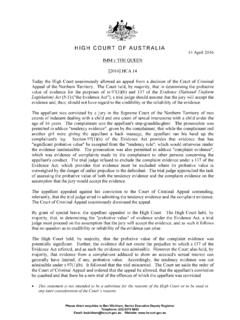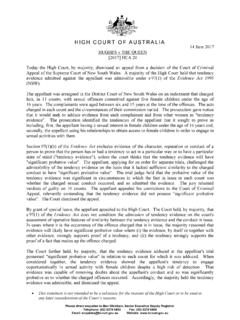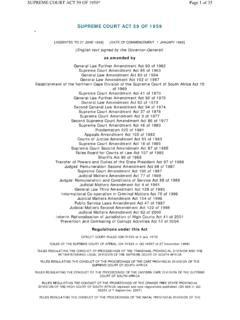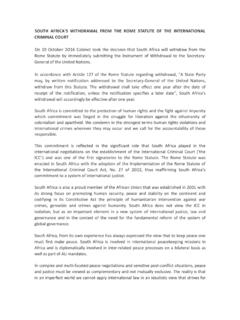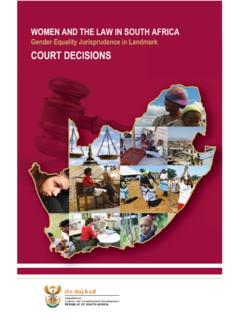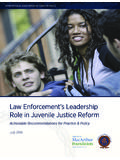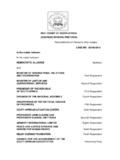Transcription of Precedent - Report on Australia, International …
1 International academy OF comparative LAW. conference , utrecht , THE netherlands . 17 JULY 2006. Precedent - Report ON AUSTRALIA . The Hon justice Michael Kirby AC CMG . The doctrine of Precedent has been referred to as the hallmark of the common law 1. It has been called the cornerstone of a common law judicial system 2 that is woven into the essential fabric of each common law country's constitutional ethos 3. Its significance in day-to-day legal practice may have declined with the rise in the quantity and pervasiveness of statute law. However, it still lies at the heart of the Australian legal system and the way Australian lawyers approach the resolution of many legal problems. Advocates of a strict view of Precedent claim that the consistency, continuity and predictability resulting from adherence to Precedent is . The author acknowledges the assistance of Mrs Lorraine Finlay, Legal Research Officer, High Court of Australia, in the preparation of this paper.
2 justice of the High Court of Australia. 1. The Hon. Sir Anthony Mason, The Use and Abuse of Precedent . (1988) 4 Australian Bar Review 93, at 93. 2. Harris, Final Appellate Courts Overruling Their Own Wrong . Precedents: The Ongoing Search for Principle (2002) 118 Law Quarterly Review 408, at 412. 3. Ibid, at 412. 2. essential to the maintenance of public confidence in the rule of law and the work of the judiciary. On the other hand, one Australian judge, justice Lionel Murphy, who served on the High Court of Australia, the nation's highest court, between 1975-1986, saw a risk of serious injustice in a rigid adherence to Precedent . He even went so far as to suggest that it was an approach "eminently suitable for a nation overwhelmingly populated by sheep"4. Somewhere between the world of slavish obedience to past Precedent and antagonism towards its rules, lies the real world of Australian law as it is practised in the courts and obeyed by those who are subject to its requirements.
3 THE INFLUENCE OF ENGLISH Precedent . Possibly the most significant change to the application of Precedent over the past thirty years in Australia has concerned the binding nature of English decisions in Australian courts. Until the 1970s and 1980s the Judicial Committee of the Privy Council in London was the final court of appeal for Australians and at the apex of our legal system. As such, in respect of any legal principle essential to the case, 4. LK Murphy, The Responsibility of Judges , opening address for the First national conference of Labor Lawyers, 29 June 1979, in G. Evans (ed) Law Politics and the Labor Movement, Legal Service Bulletin, 1980 Clayton Victoria. 3. decisions of the Privy Council were binding upon all courts, both federal and state, throughout Australia5. In addition to the severance of formal legal and constitutional ties with the Privy Council the membership of the United Kingdom in the European Union, and the increasing influence of European Community law on the development of English law, will further diminish the role of English Precedent in the future development of Australian law.
4 Australian law now rests squarely upon the decisions of Australian lawmakers and courts and the expression, application and development of Australian Precedent , with the High Court of Australia at the apex of the system. DETERMINING Precedent IN AUSTRALIA. The binding nature of the ratio decidendi: It is not the entirety of a judicial decision that will bind lower courts, but rather the ratio decidendi as determined by the reasons of the judges in the majority. As was noted by the High Court of Australia in Garcia v National Australia Bank Ltd6, the consequence of this approach to Precedent is 5. Skelton v Collins (1966) 115 CLR 94, per Kitto J at 104; Viro v The Queen (1978) 141 CLR 88, per Gibbs J at 118. 6. Garcia v National Australia Bank Ltd (1998) 194 CLR 395, per Kirby J at 417; Federation Insurance Ltd v Wasson (1987) 163 CLR 303, per Mason CJ, Wilson, Dawson and Toohey JJ at 314. 4. that the opinions of judges in dissent and all judicial remarks of a general character upon tangential or additional questions or issues ( obiter dicta ) will not become part of binding Precedent .
5 Multiple concurring judgments: Determining the ratio decidendi of a judicial decision becomes a complex task when multiple concurring reasons are published by several judges in a single case. In such a case, the ratio must be drawn from the essential areas of agreement found within the reasons of the judges in the majority. Lawyers of the common law tradition are often shocked that the civil law tradition does not generally allow the expression of honestly held dissenting opinions which they view essential to judicial independence. Moreover they are commonly left unconvinced by the very abbreviated and seemingly formulaic reasons of such courts in controversial cases, where the reasons hide the important policy concerns that common law reasoning identifies and discusses openly. It is to meet these needs that multiple reasons are common in Australian, multi-member appellate courts. Distinguishing between legal principles and orders: A distinction must be drawn between the legal principle for which the reasoning in a decision stands and the binding force of the order made in the case.
6 When the High Court of Australia overrules a previous legal decision of the Court, the ratio decidendi of that decision will no longer be binding as a legal Precedent . However, this will not affect the validity and effect of 5. the actual orders and judgment that were made in the case whose legal principle has been overruled. The reasons for this were outlined in Ruddock v Taylor7: Before a party or the community is excused from compliance with the orders of this Court it is necessary for the Court to examine the question and itself set aside, or vary, any orders earlier made, if that course is justified. No person may decide for themselves to ignore orders of this Court or treat them as invalid so long as such orders remain in force . THE BINDING NATURE OF DECISIONS OF THE HIGH COURT. Given its position as the final court of appeal in Australia, and also its position as a constitutional court, the High Court of Australia has rejected the proposition that it is strictly bound by legal holdings in its own past decisions.
7 As noted by justice Dixon in Attorney General for New South Wales v Perpetual Trustee Company Ltd, such a restrictive view would be inappropriate, given the responsibilities of the Court in the nation's governance8. Although the High Court of Australia has not established precise rules as to the circumstances in which a previous decision will be overruled, it is often said that it is not sufficient that a judge personally disagrees with the earlier decision. Instead, when overruling past 7. Ruddock v Taylor (2005) 79 ALJR 1534, per Kirby J at [169]-[172]. 8. Attorney-General for New South Wales v Perpetual Trustees Company Ltd (1952) 85 CLR 237, per Dixon J at 244. 6. decisions High Court Justices have used phrases describing the earlier decision as manifestly wrong 9, fundamentally wrong 10 or plainly erroneous 11 to emphasise the exceptional nature of such an action. In practice, the difference between disagreement and strong disagreement may be little more than a difference in temperament and judicial expression.
8 The High Court of Australia has emphasised that previous decisions should only be overruled in exceptional circumstances and that the power to do so should be exercised with caution12. The opposite applies to constitutional cases. In such cases the High Court of Australia has been much more inclined to re-examine past decisions. This is because of the entrenched nature of the constitutional decisions reached by the Court. Constitutional decisions 9. Australian Agricultural Co v Federated Engine-Drivers and Firemen's Association of Australasia (1913) 17 CLR 261, per Isaacs J at 278; The Tramways Case [No. 1] (1914) 18 CLR 54, per Griffith CJ at 58; Cain v Malone (1942) 66 CLR 10, per Latham CJ at 15;. Lange v Australian Broadcasting Corporation (1997) 189 CLR 520, at 554. 10. McGinty v Western Australia (1996) 186 CLR 140, per McHugh J at 235. 11. Babaniaris v Lutony Fashions Pty Ltd (1987) 163 CLR 1, per Mason J at 13. 12.
9 McGinty v Western Australia (1996) 186 CLR 140, per McHugh J at 235; Re Tyler; Ex parte Foley (1994) 181 CLR 18, per McHugh J at 38-39; Sleigh Ltd v South Australia (1977) 136 CLR 475, per Mason J at 501; Queensland v Commonwealth (1977) 139 CLR. 585, per Gibbs J at 599, Stephen J at 602-603, Aickin J at 620;. Hughes & Vale Pty Ltd v New South Wales (1953) 87 CLR 49, per Kitto J at 102. 7. cannot be overruled by the legislature. So long as they stand, they may only be corrected in a future High Court challenge or by an amending constitutional referendum, the latter notoriously difficult to achieve in Australia13. Further, judges of the High Court have recognized their primary and personal obligation as being to the Constitution itself, over and above strict adherence to a legal doctrine of Precedent . These factors must be afforded even greater priority when the constitutional matter before the High Court involves the protection of individual human rights and fundamental freedoms.
10 justice Brennan acknowledged this consideration in Street v Queensland Bar Association, stating that14: The doctrine of stare decisis is least cogent in its application to those few provisions which are calculated to protect human rights and fundamental freedoms . REVIEWING Precedent SUPPOSED REQUIREMENT OF LEAVE. Whilst the High Court of Australia does not consider itself bound as a matter of precedential law by its previous authority, the question has arisen as to whether it is necessary, procedurally, to obtain leave 13. In Australia, in 105 years there have been 44 attempts by referendum to amend the Constitution, often to override a decision of the High Court. Only 8 such attempts have succeeded. 14. Street v Queensland Bar Association (1989) 168 CLR 461, per Brennan J at 518-519. See also Mason CJ at 489, Toohey J at 560, and McHugh J at 588. 8. from the Court to re-argue the correctness of a Precedent of the Court. In Evda Nominees Proprietary Ltd v Victoria Chief justice Gibbs expressed the view that leave would be required.
